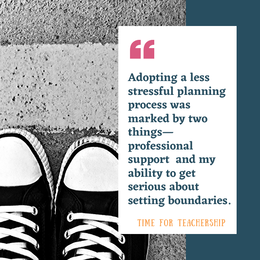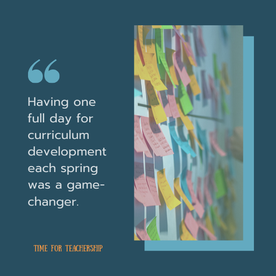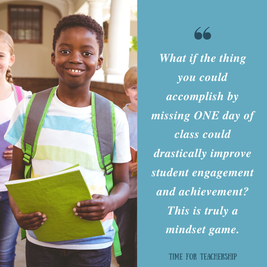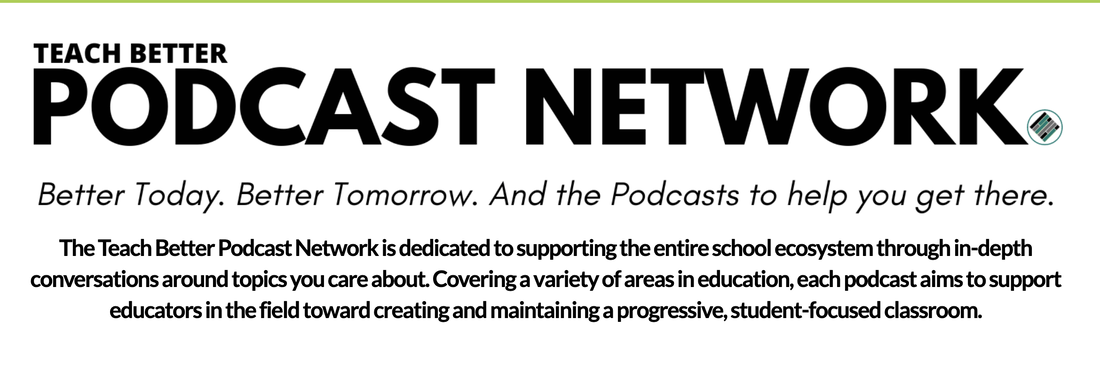|
It wasn’t until I left the classroom to become a coach that I was able to look back on my practice and deeply reflect on how my planning process changed over the course of my teaching career. I knew my first few years of teaching, my planning process—regardless of the things outside of my control like being a new teacher and having an unreasonable schedule—was a lot more stressful than my process in the second half of my teaching career. Looking back, I realize this shift was marked by two things—professional support (including quality professional development that exposed me to different ways of teaching and an administrator who encouraged us to live life during our non-working hours) and my ability to get serious about setting boundaries (committing to spending less time and eventually no time doing work at home). As I pulled together all of the specific professional development I’ve received and reflect on when I was truly at my best as a teacher (the students were most engaged and I was most energized), I realized the way I spent my non-teaching time fell into three categories: planning for quality instruction, professional development, and providing student feedback. Most teachers do these three things. This isn’t new, but what may be shocking is the percentage of time I was spending on each one. Here, it is, my 50/40/10 planning approach...
Take a moment for that to sink in. Experience all of the “This is why this will never work for me” thoughts. Then, take a deep breath and let yourself entertain the idea—if only for the rest of this post. Before we continue, if you haven’t downloaded my 50/40/10 planning bundle (updated in November to include tracker templates and activity resource banks), get it now! Let me directly address some of the hesitation that might be happening in your minds right now: I could never spend that much time on professional development. I would never finish my work! What if the professional development you spent time on taught you how to plan efficiently and grade faster and it actually saved you time in the long run? What if it helped you build engaging learning activities so that students were on-task and excited to learn every day? What if it meant you would be able to stop taking work home—the planning/grading work and the mental stress? Unfortunately, many teachers’ experiences of professional development is not helpful to their practice. It often means sitting in a staff workshop and listening to someone talk about something that may or may not have an impact on the quality of your instruction. That’s not the kind of PD I’m talking about. I’m talking about visiting a colleague’s class to see a particular strategy in action, collaboratively brainstorming an upcoming lesson idea, listening to podcasts, reading textbooks or blog posts on education specifically or another relevant topic like working efficiently, work-life balance, content you’re preparing to teach. I’m starting to curate a list of free, online resources on my “Professional Growth” Pinterest board. Check it out when you’re looking for something new to learn, or go back and read through any of the posts on this site! Also, I counted any PD offered by the school as part of my 40% professional development time. Remember, this is how you spend your non-teaching time, not your prep period specifically. This could also be grade, department, or PLC meetings. Once or twice a year, I signed up to visit another school to see what else was possible. I count this as a full day of PD in my 50/40/10 approach! Once a year, usually in the spring, the department was given one full day for curriculum development. This happened in 2 of the 3 schools I have worked, and it was a game-changer. Wait, wait, wait...you’re suggesting I leave my class for a day? I can’t do that to my kids! I want to start by saying you are a caring teacher who clearly loves your students. Now, I want to push you a little bit and ask: what if the thing you could accomplish by missing ONE day of class could drastically improve student engagement and achievement? This is truly a mindset game. I know what happens on days when you have a sub—nothing. It is a rare class that has their routines and intrinsic motivation so together they can function when the teacher is out. So, let’s play this out…Let’s say they learn absolutely nothing the day you are out. Not great. But, what if you come back energized and equipped with several ideas that will help those kiddos be enaged the rest of the year? Is that not worth it? Would you be willing to sacrifice one day of learning and the time it takes to prep sub plans (which, yes, is usually harder than being there yourself) if it meant you and your students were energized and engaged for the rest of the year? What if it just increased engagement for semester? One unit? Even if things are currently going well, ask yourselves if you believe they could be better. And while you’re thinking this through, keep the kids at the heart of this decision. It’s their learning we’re talking about. Your initial reaction may have been, “I can’t leave my kids. They’ll miss out on a day of learning.” That may happen, but are you willing to risk the students missing out on deeper, more engaged learning opportunities they could have if you went? This sounds great if PD was actually good. I don’t have access to good PD. Advocate for these opportunities. Most of the 100+ administrators I’ve worked with would be absolutely thrilled for teachers to ask to go visit another school or request PD on a specific topic. Honestly, just ask. If you’re nervous about asking, get a few other interested teachers and ask together. Grading takes way more than 10% of my time. Providing feedback to students is very important, but grading a piece of student work is just one of the ways to provide students feedback. Formative feedback is a way to provide students feedback in a way that saves you time and is more impactful for student learning! In Hattie’s book, Visible Learning for Teachers, he describes the research on formative assessment. The Main Idea summarizes, “One researcher compared rapid formative assessment to 22 other approaches to learning and found it to be the most cost effective – this is in comparison to approaches such as a longer school day, more rigorous math classes, class size reduction, a 10 percent increase in per pupil expenditure, an additional school year, and many other approaches. Rapid formative assessment, as it is being defined, is when short-cycle formative assessments occur during the lesson to provide feedback to teachers and students to help them make decisions. “Should I relearn…Practice again…Move forward?” These “in-the-moment” assessments provide immediate feedback during the process of learning. There is a lot of evidence that when these formative assessment practices are woven into the minute-by-minute classroom activities of teachers, there can be a 70 to 80 percent increase in the speed of student learning,” (p. 8). Taking time during the lesson to provide feedback may require a re-structuring of your class activities. You may need to digitize your exit slips or quizzes to be auto-graded. You may want to organize independent work time so that you can meet with students 1:1 or in small groups to provide immediate feedback. This may be a hassle, departing from the way you currently operate, but it will save you time grading and it can drastically improve student learning. So, switching to more formative assessment is more beneficial and efficient for everyone involved. Sure, you’ll still need to provide feedback on summative assessments occasionally, and for that, tech can offer some support. I wrote a post about time saving tips that features a section on grading, so check that out for more tips and specific tech tool suggestions. We could talk all day about this approach, so I’ll wrap up this post here, and prepare myself for questions. Add questions or share successes you’ve had with the approach in the comments below or on our private facebook group. I’m excited about the transformative power of this approach to planning, and I can’t wait to continue supporting you on this journey!
2 Comments
7/24/2024 10:48:01 pm
How did professional support and setting boundaries contribute to the shift in your approach to teaching and work-life balance?
Reply
Leave a Reply. |
Details
For transcripts of episodes (and the option to search for terms in transcripts), click here!
Time for Teachership is now a proud member of the...AuthorLindsay Lyons (she/her) is an educational justice coach who works with teachers and school leaders to inspire educational innovation for racial and gender justice, design curricula grounded in student voice, and build capacity for shared leadership. Lindsay taught in NYC public schools, holds a PhD in Leadership and Change, and is the founder of the educational blog and podcast, Time for Teachership. Archives
May 2024
Categories |






 RSS Feed
RSS Feed